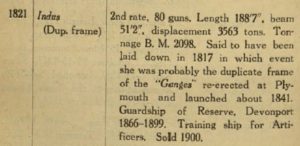In his (much-examined, much-copied, and probably much-misunderstood) Last Will and Testament, Andre Bernardin Nageon de l’Estang (1715-1750) claimed to have retrieved “richesses de l’Indus” and hidden it in some kind of cave (presumably in Mauritius, where he lived and died). Consequently, many treasure hunters have trawled historical archives for ships called “Indus” with dates that match Bernardin’s life-time: but with no success to date. Other (slightly later) Indian Ocean ships were similarly called “Indus“, so it is at least plausible that it was indeed the name of a ship.
And so I wondered: if an “Indus” had been built in the Indian Ocean not too long before 1750, where would it have been built? I knew that Daniel Krieg’s favourite Indus (captured by the French in 1782) had been built in Bombay Dockyard, so that was where I began my search…
The Bombay Dockyard
The book I found was really rather splendid: “The Bombay Dockyard and the Wadia Master Builders” (1955) tells the story of how a multi-generation family of master boat-builders – starting with Lowjee Nusserwanjee Wadia (1710-1774) – proved pivotal to the development and success of Bombay Dockyard.
This book includes all kinds of wonderful notes, such as on p.99: “The reason why the majority of the ships between the years 1748 and 1772 were of 499 tons was because all ships of 500 tons and more had to carry a chaplain. To avoid this additional charge the ships were rated at 499 tons.“
The first mention of Lowjee [it says on p.124] appeared in Surat Diary No. 620 (dated 29th July 1735): “Lowjee a shipbuilder of this place (Surat) informed them (Surat Council) about some twenty-eight Englishment who had run away […]”. Lowjee then travelled (with ten other carpenters) from Surat to Bombay on the Cowan: he arrived in late March 1736.
The first sizeable boat built at the Bombay Dockyard (p.131) was “a ship of about 200 tons”, ordered by the Madras Government in March 1738. This was the Princess Augusta: a sloop was also constructed for Bengal, with both finished in April 1739 (p.132). More boats were built or repaired:
- 12 Aug 1740: “Restoration” launched
- May 1741: “Neptune Prize” repaired
- Jul 1741: sloop “Porto Bello” launched for the Bengal government
- 21 Aug 1742: ship “Success” was launched
- Jul 1743: brigantine “Brilliant” launched
April 1742 (p.135), the Court of Directors decided too much money was being spent on boats, and so stopped boat construction. Prior to that “reduction”, the Bombay Marine consisted of “one ship of 44 guns, four of 28, four of 18, six bomb-ketches and twenty large gallivats”.
In 1744 (p.136), the Bombay Marine had “2 ships of 28 guns, one grab of 20 guns, five ketches carrying 8 to 14 guns, and 8 gallivats”.
1748: three sloops (“Grampus”, “Bonnetto”, “Dolphin”) were built for the Bengal Pilot Service.
Might Bernardin’s (alleged) Indus have been one of these? It’s possible, though it doesn’t appear under that name on the list of ships built at Bombay (p.329 onwards). Here’s the list from the 1740s:
We can see a later Indus being built here (in 1776), that I’m sure Daniel Krieg will recognise:
And another in 1821:
And another in 1851:
But nothing earlier.
I shall continue looking…




Nick,
I don’t know what the situation was during the 18thC. but Kerala is an ancient boat-building centre – not least because (to quote Clemesha)
“The only place where the materials for ships could be obtained in the Indian ocean was the Malabar coast of India. This was the origin of the great importance of the trade with southern India. It is no exaggeration to say that practically every ship that was built in the Indian ocean (excluding catamarans and sampans) was built with Malabar timber…Not only did the forests on the western Ghauts [Ghats] produce an adequate quantity but the quality was of the finest in the world. It is today [1947]”
The old traditions in ship-building must have survived to some extent because when it was decided to reconstruct the ship described on cuneiform tablet of 1800 BC, it was to Malabar ship-builders they went. On this, if you haven’t seen it, Irving Finkel’s well-illustrated lecture on the project is as delightful as you’d expect of him.
https://www.youtube.com/watch?v=s_fkpZSnz2I
Anyway, I thought it might be worth your time to check out what. if anything, was happening about ship-building in eighteenth-century Malabar.
No longer have the article, only a note that it was in Journal of the Polynesian Society, Vol.52, No.3 (1943) pp.110-131
Diane: thanks for that, I’ve got some other posts on the general theme of boats in India circa 1747 in mind, the Bombay Dockyard was sinply an obvious starting point given that other ships called “Indus” were built there not long after.
Nick Pelling: There was a pilot vessel named ‘Indus’ of BM 140 tons launched Bombay dockyard 1776, captured by the Frogs in 1782 then later renamed ‘Industry’. Does that help?
John Sanders: that’s the Indus I posted about a few days ago, but it’s a bit late for the date – https://ciphermysteries.com/2023/08/02/daniel-krieg-on-the-1782-indus
Nick Pelling: bully for you sport. The other Indus named ships that appear from my research be one in Amsterdam 1789, two in N’Castle-O-T in 1803 & 1813 and another at Newbury Mass. 1817. All a bit late for the date as you suggested a few days ago apparently.
Nick,
Was delighted to find that all articles published by the Polynesian Society Journal since it began (it was not incorporated until 1943) are now listed on their website so I’ve checked the details of that article.
William Wesley Clemesha, C.I.E., M.D., D.P.H., LT.-COL. I.M.S. (retd.)
‘The Early Arab Thalassocracy’
JPS Vol.53 No.4 (September issue) 1943 [not ’47, sorry] pp.110-132.
Cheers